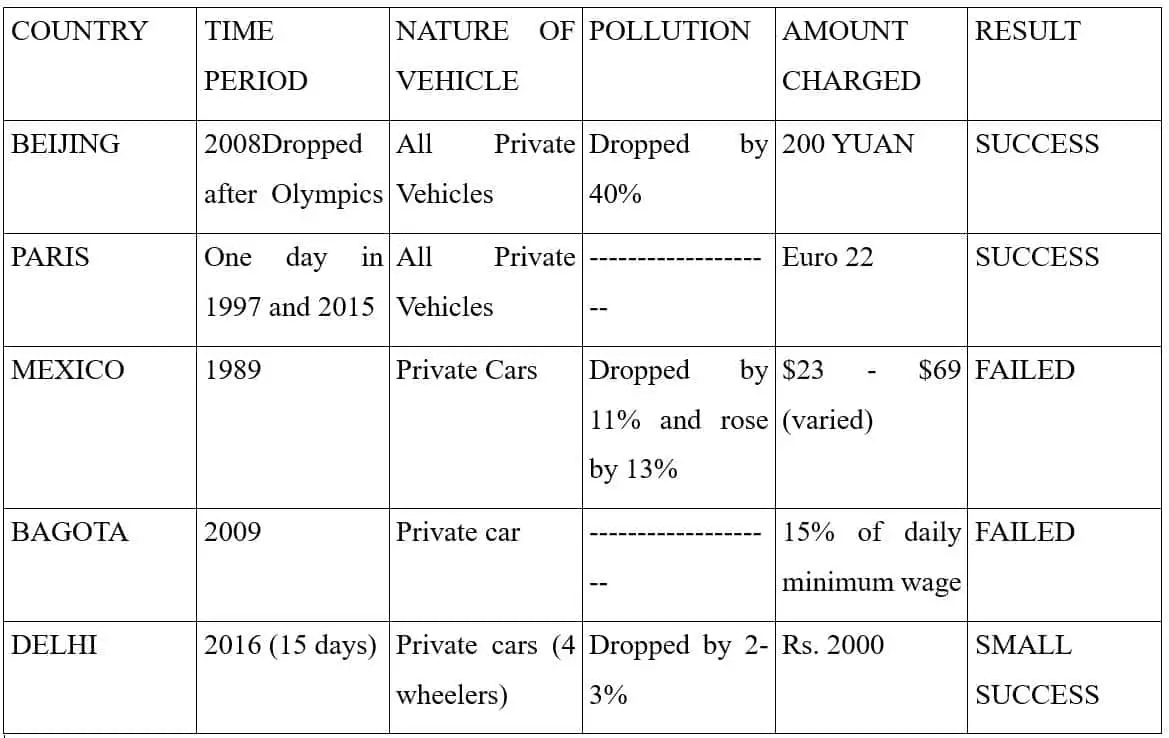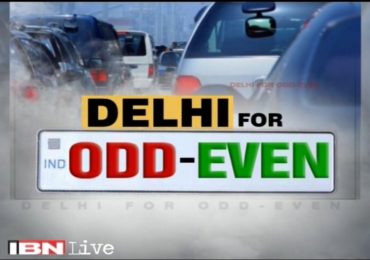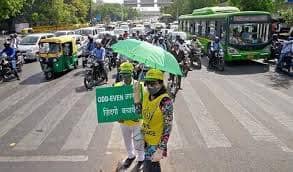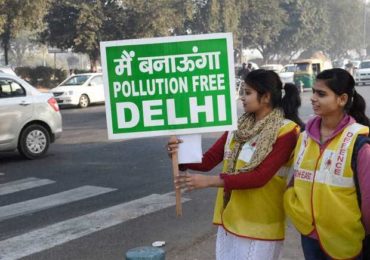Odd Even scheme as a tool for traffic management & pollution reduction
The smooth operation of a transportation system demands limited usage of private vehicles and a widespread consumption of public vehicles with adequate infrastructure to support it. However, a tendency within the citizens to travel in increased comfort and showcase a status symbol alters the basic norms around transportation and results in vehicular congestion, reduced average speed and pollution level of a city. Social mobility in a city is connected to physical mobility, shifting from public vehicle to a two wheeler or from a two wheeler to a four wheeler acts as a catalyst in enhancing the social status of a person (Ghate and Sundar; 2014). Different policies exist within the domain of transportation which may be viewed as a measure to correct the system. The different policies include congestion pricing or peak pricing, regulating the parking prices, odd and even scheme or use of planning mechanisms like transit oriented development within a city.
The odd and even scheme has been used by different cities across globe to deal with the problem of congestion and pollution. It attempts to control the number of vehicles on the road on the basis of the number plate or the nature of the vehicles.
Odd Even Rule in different countries
Different countries have implemented the odd and even policies at some point in time and the results vary widely due to difference in demography, public participation, related policies etc. The scheme was imposed in Beijing in 2008 before the Olympics where private vehicles with odd and even number plated cars were allowed on the roads on alternative days. In Paris, the odd and even scheme was used twice each 1987 and 2014 thereby achieving its pollution control goal in one day. Cars were banned from entering the city as per the decided number plate between 5.30 and 12.00 A.m. Before the implementation of the scheme it was ensured that the average speed of the car was reduced by 20 km/ hr one week before the scheme implementation and during the day of the application, the public transport would be free. The city of Mexico witnessed the application on the Odd and the Even Scheme in 1989. With an initial drop in the pollution level by 11%, it was noticed that this scheme appealed to the people as an incentive to buy a second car and the pollution rose by 13%. Had there been strict policies around the purchase of the car as in China, then the pollution control tool might have worked. In Bagota, cars were banned for during two days in a week during the peak hour. In order to make the policy strict, the combination of the numbers fluctuated every year. However, a reverse effect was seen when the traffic shifted to off peak hours (Anirudh; 2016).

Odd Even Rule in Delhi – Implementation, Merits & Demerits
The Odd and even Scheme has been considered as a pollution control mechanism widely, however neither does it come with the assurance of positive result nor does it operate independently in a city. The success of this scheme depends on the economic, political and social set up of a city. A similar tool was experimented with in the city of Delhi where the level of pollution was very high and had to be controlled immediately to protect the citizens from a poisonous atmosphere. The implementation of the odd and even policy was viewed by the ‘Aam Admi Party’ as a measure to counter the increasing pollution levels in Delhi. The arguments below show the merits and demerits of the policy in the city.
Demerits
Implementation of the wrong policy- The purpose of the scheme was to curb the pollution levels in Delhi, studies argue that the policy which was implemented was not well equipped to address the concerned issue. There are various reasons for the existing pollution levels in Delhi which have to be dealt simultaneously like pollution from industries (10%), dust from the road (56%), concrete batching (10%), burning of the fuel (12%) which have to be addressed first to deal with the issue at hand, thus it was argued by critics that the decision to implement the odd and even scheme was a hasty one and the scheme aimed at dealing with vehicular pollution which constitutes 9% of the stake in air pollution (Jha; 2015).

Success questionable- Success of a policy like the Odd and even is doubtful in a city like Delhi which does not have strict policies around transportation. Delhi does not have any congestion pricing nor does it have policies which puts a cap on the purchase of more than one car. The regulation of the parking fee is also very weak and the same fee structure has been continuing in Delhi since years. There are countries like Singapore which have very high parking prices while there are some cities like Shanghai where one needs to arrange for a parking space before buying a car. Such policies may lead to success of schemes like the Odd and Even or else the consumer gets an incentive to buy another car which defeats the whole idea of curbing vehicular pollution. Studies also suggest 19% of the commuters shifted to second car in the second phase while 6% did so in the first phase in Delhi (Scroll.in; 2015).
Failure in controlling pollution- The odd and even scheme produced very disappointing results with respect to curbing the air pollution. Different research were conducted by premiere institutions like TERI and IIT Kanpur which showcased poor results of the two phased 15 days scheme. The first phase did give satisfactory results but in the second phase, the pollution rose by 23% despite having almost the same vehicles on the road. The study also suggests that the number of challan violators reduced in reduced during the second phase (Jain, 2016)

One of the reasons for only10% (IIT Kanpur) reduction in the pollution level could be because of the low coverage as the policy has provided a wide range of exemptions. It has also been criticized of the grounds that the two wheelers which constitute 51 lakh of 89 lakh registered cars in Delhi and are responsible for 33% of the vehicular pollution (Jha; 2015) were not a part of the scheme. However the Chief Minister of Delhi has defended himself with the argument that the public transit will not be able to support the large number of three wheelers.
Inconvenience for the mass- One of the major criticisms which the odd and even scheme faced in Delhi was that it did not take the opinion of public into consideration who would be the major beneficiaries or the losers of the scheme, thus it did not appear to be very democratic. The public transport in Delhi is still developing and was not ready absorb the population of Delhi which also has migrants from nearby places like Ghaziabad, Manesar, Faridabad etc. visiting the city for the purpose of work or education. Though the school buses were used to accommodate the population, the demand was far more than the supply. The metro in Delhi does not connect to all parts of the city and many corridors are still under construction and the buses were far less than what was supposed to be. Though the government controlled surged prices of the hired cabs, the demand could not be absorbed as cab providers like OLA and Uber run out of cars during peak hours. Autos in Delhi operate in a very informal fashion and during such events, the auto took the call which customer would they like to entertain as per the distance being travelled and they would quote the price randomly.
Police Under Pressure- Implementation of such an ambitious scheme successfully demands a well equipped and large number of police force. The police forces in Delhi were overburdened to control the mass as a disturbance in the everyday operation of the city could generate unforeseen consequences. As the scheme was for a trial basis, people from different departments joined in to monitor the operation as the Delhi police was understaffed and vehicle identification would be difficult because of a plethora of exemptions like women, disabled, cars of the politicians etc. In an article by ‘India Today’, it was reported that charging a violator during peak hour gets difficult, in such a case, the job would be more cumbersome and the police forces need to be increased by 70% in order to employ 3000 representatives on the ground daily. This also implies that a scheme of such a nature cannot be applied in a city like Delhi for a long term basis with the existing infrastructure (Meghnani; 2015).

Merits
Relief from congestion- Though the primary motive of the odd and even scheme was to reduce the pollution levels, a positive impact was seen in the traffic on the roads. According to the reports of ‘The India Express’ an approximate reduction of 9-10% was experienced in the travel time. The bus services in Delhi became more efficient because of decongestion. Ideally they have a daily target of 200 km but congestion in the streets of Delhi makes them achieve only about 160 km per day but during the implementation of the scheme they covered about 220 km per day. The sale of fuel also dropped due to the restriction of vehicular mobility on the roads (Chaudhary; 2016). Places like Vasant Kunj, Pragati Maidan and ITO saw a significant fall in the number of commuting vehicles.
Cooperation by private companies- Car Pooling saw an altogether different rate of enthusiasm in order to generate business for themselves which had a positive result on the scheme. Instances of car pooling were seen in Delhi where many people heading towards a common or places nearby were travelling by the same vehicle. The fashion of ride sharing started then in Delhi and continues till today. Business of Ola in Delhi had increased through its options like ‘Ola Share’ and so was done by the other the substitutes like ‘Uber’ and ‘Meru Cab’. In view of publicity and marketing ‘Ibibo Ryde’ showed the CO2 saved and the rides taken, it also distributed pollution masks and badges with odd and even written on it to enhance the visibility. ‘Hike’ launched the app called car match to help connect with potential co passengers in a car pool. Auto supplies rose in areas like NCR through ‘Auton Cab’ and ‘M-Taxi’ doubles and extended its supply for two hours. There were also apps launched to help people check the fluctuating pollution level (Johari; 2016)
Citizen culture-The Odd and Even scheme may be viewed as an experiment which tell us a lot about the citizen culture in Delhi and acts as a medium of education for them. Studies carried out post the experiment says that the citizens were very cooperative in the hold experiment. We may formulate this view on the grounds that there was no unrest reported throughout the time period of the operation. It also helps us determine that the people in the city are ready for such new policy initiatives. The amount collected in Phase I was Rs. 2.01 crore which fell down marginally Rs. 1.91 crore in the second phase (Hindustan Times; 2016). The number of cars reduced, the number of violators reduced in the second phase and an amount a high as Rs. 2000/- was paid by the citizens which suggests their level of cooperation as (Lalchandani; 2015) right argues that the success of such moves requires a change in the culture and cannot be forced upon the people.

Delhi was surrounded by the problem of extremely high levels of pollution which was approximately 10 times more than the safety level fixed by WHO (Greenpeace; 2015). Multiple sources contribute together towards the alarming pollution in Delhi, vehicles being one of them. A simple and rational solution would be to make commuting so convenient in a city that other modes of travelling are good enough to motivate people to leave their luxurious 4 wheelers. Ensuring last mile connectivity through mass rapid transit like the metro which is efficiently operating in Delhi will increase the reliance of the people on public transport and government.
In Delhi, the public transport is not well developed to cater to the needs of all its citizens and investment in the huge infrastructure development is also questionable. Looking at the Indian scenario, an important question which is likely to be raised is what is the way out to operate the mass transit efficiently. The Public Private Partnership projects run into losses due to low returns from the projects to reduce the pressure on the citizens (Airport Express Line) and the government projects get delayed and lack the technical skill, expertise and efficient research on a project.
It is also interesting to point out that the urban planning in Delhi is flawed and demands correction. A report by TERI suggests that the planning of the city goes a long way in deciding the consumption pattern. The roads in Delhi are car friendly which acts as an encouragement for the people to travel by cars. Existence of new road and flyover projects, easily available car loans, subsidies of fuel should be curbed to check the private vehicle consumption. If the capacity of the roads is increased, people will end up using cars (Ghate, Sundar; 2014), thus the ‘design, framework and urban planning’ need to be checked for the successful implementation of transport policies.
The city of Delhi has been designed on the lines of a master plan which according to Dupont is exclusionary in nature. The plan has ignored the socio- economic needs of the whole society and serves the interests of a particular section of the society. The master plan has been designed on the estimated increase in the number of cars which clearly shows that consideration has been given for awarding more urban road space to the cars (Ghate and Sundar; 2014). The question is how will a substitution of public transport take place? Even if the public transport service is enhanced, where will it operate as the space in a city is limited?
Thus we may argue that a mere thought is not enough and initiatives should be taken to alter the consumption culture within a city. Cycle tracks can be developed so that short distances can be covered through them. This again is a challenge for Delhi because the high rate of pollution in the city will be a major source of discouragement for the usage of bicycles and instances have been seen in cities like Pune where bicycle tracks had been encroached upon by street vendors and the purpose of the green initiative gets defended. Do we blame the street vendors? How do they earn their livelihood? Have the policies for them and their livelihood practising been sorted? Can we say that rather than declaring them encroachers and subjecting them to repeated confiscations, a way of accommodating them should be found out. This brings us to the question of safety. Delhi which is the capital of India is widely acknowledged as the ‘crime capital’. How will the people specially the women walk on road or take bicycles if the roads are not well lit and has people around.
We may also sat that the laws and policies around transportation is an area which is compromised upon and need to be formulated efficiently and made stricter through efficient vigilance. Community participation can be encouraged where an agency can be set up and acts alertly on the complains made. Delhi can also set up emission targets to deal with the issue of vehicular pollution, it should also keep going with its system of ‘Pollution Under Control or ‘PUC’ certificates.
Author Bio: Avnika Nagar is a Masters student at Tata Institute Of Social Sciences, Mumbai.
REFERENCES
Ghate, A. T., & Sundar, S. (2014). Proliferation of Cars in Indian Cities: Let Us Not Ape the West. Policy Brief: The Energy and Resources Institute (TERI).
Jha, S. (2015). Oddity of Managing Air Pollution in Delhi: Public Policy Myopia.
Chaudhari, P. R., Verma, S. R., & Singh, D. K. Experimental Implementation of Odd-Even Scheme for Air Pollution Control in Delhi, India.
Chaudhary, C. (January 18, 2016). Delhi’s odd/even scheme inspires, even with mixed results, The Third Pole.
net https://www.thethirdpole.net/en/pollution/delhi-odd-even/
Jain, M. (May2, 2016). Choking Cities:Five charts show why odd-even isn’t helping curb Delhi’s pollution problem – or cut congestion Scroll.in.
https://scroll.in/article/807497/five-charts-show-why-odd-even-isnt-helping-curb-delhis-pollution-problem-or-cut-congestion
Johar, S.(2016). Carpooling high during Delhi’s Jan odd-even rule as public transport bottlenecks, Medianama.
https://www.medianama.com/2016/02/223-delhi-odd-even-rule-carpooling/.
(December 31, 2015). How other countries are experimenting with odd-even system, Down To Earth.
https://www.downtoearth.org.in/news/air/how-other-countries-are-experimenting-with-odd-even-system-52261
Anirudh, Odd and Even Regulations Around The World, Spinny. https://www.spinny.com/blog/index.php/odd-even-regulations-around-the-world/
Meghnani,
S. December 26, 2015. Delhi Police ‘concerned’ over implementation of odd-even car number scheme, cites shortage of 10,000 personnel, News 18.com.
https://www.news18.com/news/india/short-staffed-delhi-police-says-road-rationing-scheme-will-be-difficult-1181851.html